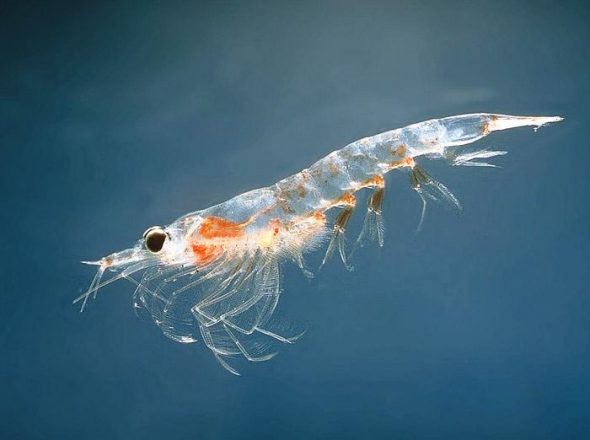
The shrimp-like Antarctic krill. (File photo/Modern Express)
Chinese fisheries venture to ends of the earth in hopes that Arctic and Antarctic seafood will catch on
Ever wondered what shrimp from the South Pole tastes like?
A group that was part of China's 31st Antarctic expedition recently announced plans to significantly expand industrial fishing operations to bring Antarctic krill - a species of small, semi-transparent crustaceans that look like rainbow-colored shrimp - to diners in China.
With the biomass estimated at 500 million tons, Antarctic krill is responsible for supporting much of the region's ecosystem, providing an invaluable food source for other animals including seals, whales and penguins.
China's Antarctic Krill Group, which was founded in April 2012 as part of the country's 28th Antarctic expedition, is hoping to add humans to the list.
"Eaten raw, they taste quite sweet," said Ying Yiping, a researcher at the Yellow Sea Fishery Research Institute, who sampled fresh Antarctic krill on a scientific expedition to Antarctica in 2013. "Boiled, they taste like fresh river shrimp."
However, concerns have been raised that industrial harvesting operations could destabilize the natural ecology of the region.
Since 2004, marine ecologist Angus Atkinson, formerly of the British Antarctic Survey in Cambridge, has expressed fears over declining Antarctic krill populations due to global warming and commercial fishing industries, which poses a significant threat to other animal populations.
Commercializing krill
Ying said while the market for Antarctic krill in China is currently small, a commercial industry for it already exists, as it is used as an ingredient in some oils, pastas and sauces.
According to news website guancha.com, China was granted permission by the Commission for the Conservation of Antarctic Marine Living Resources (CCAMLR) to begin commercial fishing of Antarctic krill in 2010.
The CCAMLR 2012 Statistical Bulletin lists Norway, South Korea and Japan as the largest fishers of Antarctic krill, with a combined yield of 159,492 tons in 2011. In the same year, China took 16,014 tons of Antarctic krill, according to the report.
Li Lingzhi, a researcher at the East China Sea Fishery Research Institute, told guancha.com that the announced plans to ramp up fishing of Antarctic krill by Chinese fisheries could be seen as part of broader strategy to explore high sea resources, in order to alleviate offshore fishing resources which have depleted in recent years.
Shi Jie, a Beijing-based nutritionist, said that Antarctic krill was high in protein and low in fat, as well as being a rich source of amino acids and antioxidants.
"From a nutritional point of view, I think the best way to eat fresh krill would be raw, or sashimi-style," she said.
Shi said it is crucial that it is rapidly processed through quick-freezing, as Antarctic krill deteriorates very quickly.
Besides Antarctic krill, Ying said there were two other species found in Antarctica that could be a valuable food resource in the future: the Patagonian toothfish (more commonly known as "Chilean Seabass") and the crocodile icefish.
"Both fish are larger and have a high commercial value, but China currently does not have permission to commercially fish these two species," said Ying.
In 2010, Greenpeace International added the Patagonian toothfish to its "red list" - a list of common foods whose sourcing is likely to be unsustainable.
















































